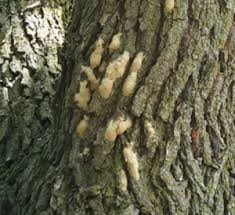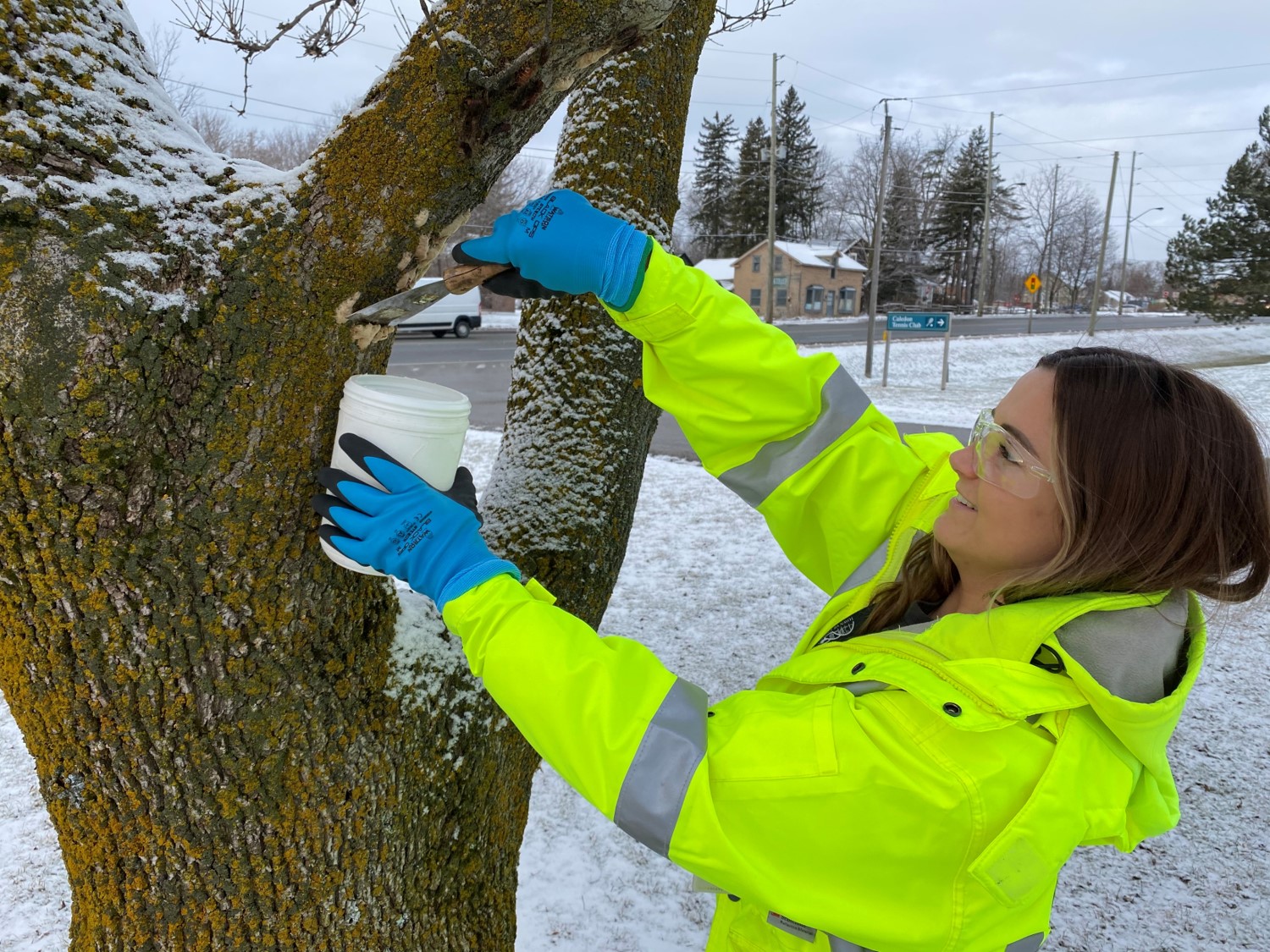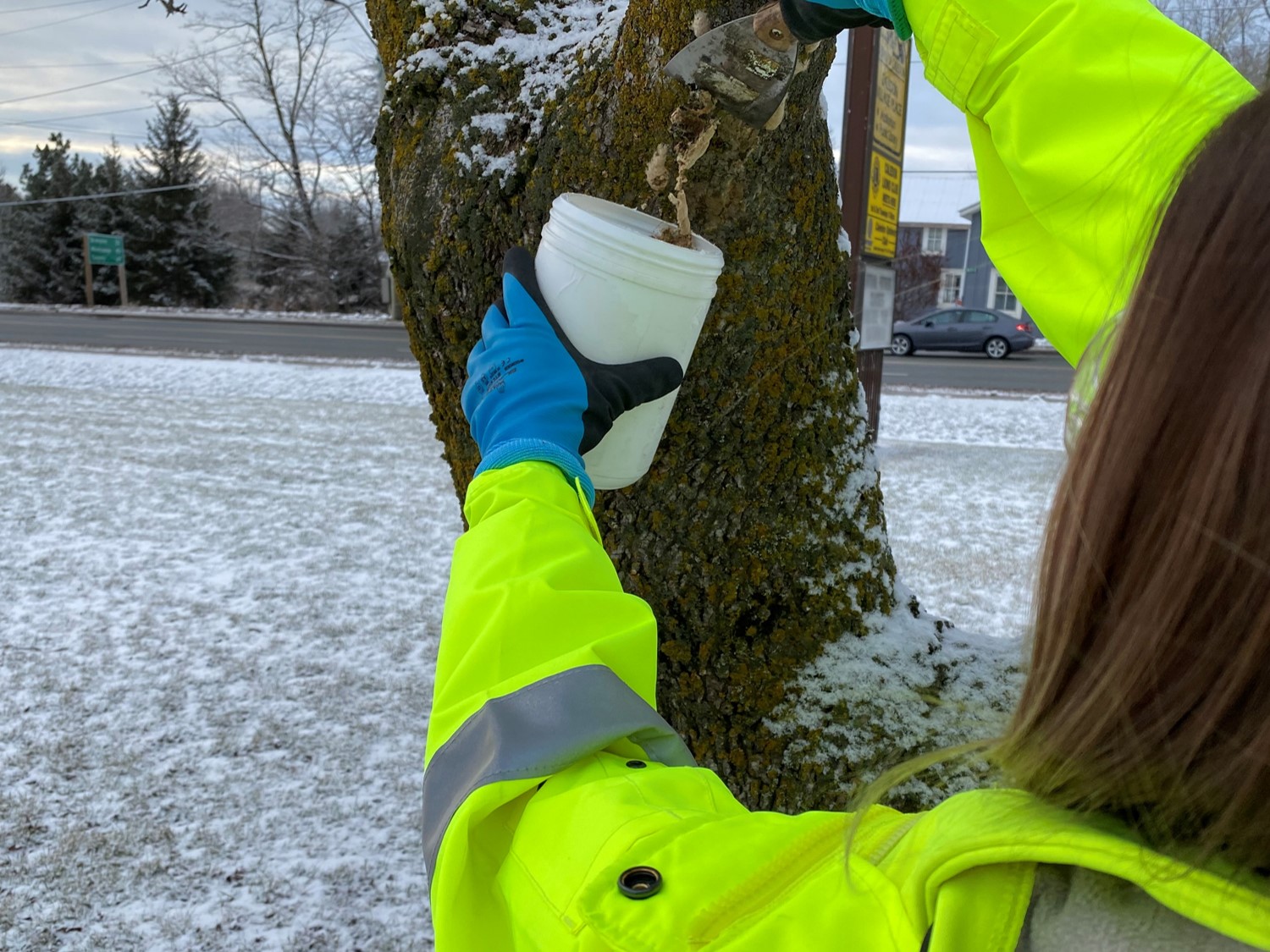Spongy (LDD) Moths in the Town of Caledon
Please note - This web page is no longer being updated. For the latest on Spongy Moths in Caledon, please visit our dedicated Spongy Moth web page.
Overview
| What is the spongy moth? |
|
The spongy moth is an invasive moth species from Europe that has established in southern Canada, as well as the eastern and central United States. It is a forest pest of concern because of the ability of the moth’s larvae (caterpillars) to defoliate trees (consume leaves). Healthy trees can typically survive severe defoliation by the spongy moth larvae; however, repeated defoliation stresses trees and makes them more vulnerable to other forests pests, diseases and drought. Though the spongy moth accepts many tree species as its host, some of the more-preferred hosts include oak, maple, alder, beech, and birch species. Defoliation from larva feeding on leaves typically stops in early summer when the caterpillars have entered the pupae (cocoon) phase for one-to-two weeks. Male and female adult moths then hatch from pupae around mid-July, but do not feed on the leaves of the trees. Instead, the adult moths spend their short-lived lives reproducing and laying egg masses to restart the life cycle. Spongy moth population outbreaks occur in cycles, so while there may be an aggressive infestation one year, it does not mean it will continue year after year. |
| Learn more about the spongy moth |
|
Learn more about the spongy moth’s life cycle and impacts:
NOTE: Some of the resources may address the species as "LDD moth". |
2023 Spongy Moth Updates
Results of summer 2022 defoliation (leaf consumption) surveys and fall 2022 egg mass monitoring efforts suggest that the 2023 spongy moth population and impacts in the Town of Caledon will be minimal. A combination of successful management in 2022 and biological characteristics of the spongy moth population cycles suggests wide spread management by the Town will not be required in 2023.
The Town will continue to monitor localized areas with high occurences of spongy moth throughout 2023 and manage on a as needed basis. Management options used in 2022 will be applied as necessary.
What can residents do?
Together, we can continue to monitor and manage the spongy moth in Caledon. Here's what you can do as a resident:
Inform us about spongy moth on Town property
If the spongy moth is seen on Town property, please contact Service Caledon at 3-1-1, email info@caledon.ca. It will be investigated by the Town Invasive Species Coordinator or Arborist. Or you can report a sighting to our Spongy Moth Tracking Form (see below).
Report spongy moth on public and private property
Report spongy moth during its various life stages on public and private properties throughout the Town!
Your efforts will help increase spongy moth monitoring data used by the Town to inform management decisions for the invasive moth across the municipality.
Submit a report using our tracker form:
Check out other reports on the interactive Spongy Moth Tracking Map:
Please note: Using the reporting tool will not initiate a inspection by the Town Invasive Species Coordinator or Arborist. Please contact Service Caledon at 3-1-1 or email info@caledon.ca to request a inspection.- reporting Lymantria dispar to the Early Detection and Distribution Mapping System or report an insect form
- calling the Invading Species toll-free hotline at 1-800-563-7711
- emailing info@invadingspecies.com
Manage spongy moth on private property
The Town does not provide service to private properties. For effective management, property owners need to consult with their chosen tree care professional to determine the best way to manage trees on their own property. See How and when do I protect trees on my property? in the Frequently Asked Questions for management options for landowners.
Frequently asked questions
| What is the spongy moth? | ||||||||||||
| The spongy moth is a major forest pest in North America. In the larval (caterpillar) stage, the insect eats the leaves of trees making host trees more susceptible to disease and damage from other insects. Large infestations of caterpillars also pose a threat to people due to the large amount of frass (caterpillar droppings) produced, and hairs found on the larvae and pupae (cocoons) can cause skin irritation and allergic reactions. | ||||||||||||
| How much damage can the spongy moth cause to trees? | ||||||||||||
| Depending on the level of infestation, damage can range from light to almost complete defoliation or loss of leaves. Healthy trees can typically survive severe defoliation by the spongy moth caterpillars; however, repeated defoliation stresses trees and makes them more vulnerable to other forest pests, diseases and drought. In some situations, if the tree has been weakened or stressed by other conditions, the trees health will decline. | ||||||||||||
| What kinds of trees are most affected by the spongy moth caterpillar? | ||||||||||||
| Over 300 plant species have been known to host the spongy moth, and 150 are considered “favoured hosts” (Invasive Species Centre, 2022). Spongy moths prefer oak trees but will eat all kinds of hardwoods including alder, beech, birch, linden, maple, and poplar species. Less-favoured host species include: ash species, sycamore, butternut, black walnut, dogwood or balsam fir. | ||||||||||||
| What is the lifecycle of the spongy moth? | ||||||||||||
|
Like other Lepidopteran species (moth and butterfly species), the spongy moth has an egg, larval, pupal, and adult life stage. Eggs are protected by a golden brown or yellow fuzz, in the form of an egg mass. One egg mass can host between 600 and 1000 spongy moth eggs. Egg masses stay dormant all winter and hatch the following spring during late April to mid-May. CAUTION: spongy moth larvae contain hairs that can cause skin irritation or allergic reactions.
CAUTION: spongy moth pupae also contain hairs that can cause skin irritation or allergic reactions.
Adults (moths) are short-lived and seen in mid-summer. Both genders die after the (flightless) female lays a single egg mass on the limbs and/or trunk of the host trees. Egg masses can also be laid on surrounding rocks, buildings, or in other sheltered areas. Male moths are brown in colour, and females are white with dark markings (and larger in size). The moths do not feed on the host tree, they only reproduce. |
||||||||||||
| Are there any natural predators to the spongy moth? | ||||||||||||
|
Yes. Natural predators include parasitic wasps, beetles, and mice. When caterpillars first hatch, birds such as chickadees, blue jays, robins and nuthatches may prey on them. Young caterpillars contain fewer irritating hairs than adult caterpillars, making younger larva easier for animals to eat. Spongy moth populations are also reduced by diseases caused by fungi and viruses. |
||||||||||||
| How and when do I protect trees on my property? | ||||||||||||
|
Depending on location and seasonal conditions, timing for managing infestation may overlap. These methods are also intended for individual trees and not large-scale woodlot management.
|
||||||||||||
| How do I find spongy moth eggs? | ||||||||||||
|
Inspect your property for egg masses between mid-August and the end of April of the following year. Conducting two search and removal efforts (one in the fall and one again in early spring) will ensure that all accessible egg masses will be found and destroyed. It is easiest to spot egg masses when the leaves are off the trees and shrubs. Start in one corner of your property and walk in a systematic manner making sure to look high and low, on all types of vegetation and structures. Spongy moths lay their egg masses just about anywhere; but they prefer sheltered locations. Be sure to look at all natural and unnatural structures such as the underside of branches or bark, the underside of patio furniture, on stacks of firewood, rocks, and fences. Inspect all surfaces of your house including windowsill, under eaves, around bird houses or mail boxes as well. LDD egg mass removal:
NOTE: Wear gloves when handling caterpillars and/or pupae since they contain hairs that can cause skin irritation or an allergic reaction.
|
2022 Spongy Moth Management
January to April 2022 Management Efforts
| Spongy Moth Monitoring |
|
The Town completed spongy moth monitoring by counting and assessing dormant egg masses attached to Town trees (located on the Town-owned section of streets and woodlot areas) throughout the municipality. Over 150 locations were monitored from January to March 2022. The Town will use the monitoring data to predict the loss of leaves as well as what the 2022 outbreak population may look like. In general, monitoring has indicated that there is evidence of natural predators (birds, parasitic wasps) feeding on the egg masses. Overall, we have observed many masses which have not been intact or a “golden brown". This indicates they are not in a healthy condition or are egg masses from previous years. |
| Egg Mass Scraping |
|
Based on 2021/2021 egg mass monitoring data, 38 streets were selected for egg mass scraping efforts by the Town of Caledon’s Forestry Team. A total of 454 trees were scraped in the month of March based on monitoring efforts, and 15 locations were scraped based on service requests initiated by residents. |
| Meet the Invasive Species Coordinator, LDD moth name change, and what the Town is doing in 2022 |
|
Watch this video to meet our Invasive Species Coordinator and get an update on what the Town is doing to manage spongy moth throughout the municipality. |
May to June 2022 Management Efforts
| Burlap Band Handouts |
|
To help landowners manage spongy moth on private properties, the Town provided free burlap kits for pick up at various locations. Each kit contained two burlap bands, two pieces of twine and a burlap band how-to guide. Kits were made available in late April, and over 1000 kits were picked up by residents or handed out at various events hosted by the Town.
|
| Ground Spraying Trees with Btk Biopesticide |
|
Town of Caledon Forestry staff, and licensed exterminators working on behalf of the Town of Caledon sprayed trees with two rounds of Bacillus thuringiensis subspecies kurstaki (Btk). Btk is made from a naturally occurring bacterium found in soil and is the active ingredient in biological pesticides (biopesticides) approved for spongy moth management by Health Canada. Btk was applied via ground spray application, using hydraulic sprayer equipment. For effective protection against spongy moth, a single tree required two Btk applications (about two weeks apart) to its leaves. When a spongy moth caterpillar consumes treated leaves, the Btk activates in the stomach of the caterpillar and kills it. Only select trees that met specific size requirements and/or infestation levels were treated via ground spraying. |
| Tree Injection with Biopesticide |
|
A second treatment option performed by licensed contractors was tree injections. Injections are conducted by drilling shallow holes into the trunk of a tree and placing canisters filled with a biopesticide inside the holes. Like water, the tree naturally uptakes the biopesticide and absorbs it into the tissues of the tree. The pesticide used for tree injections is TreeAzin Systemic Insecticide®. It is also a biopesticide since its active ingredient is made from Neem tree (Azadiracta indica) seed extract. For effective treatment results, trees only require one injection treatment in a year. Overtime, the tree will heal and re-fill the holes within its trunk. For more information on TreeAzin® visit the BioForest website. Only select trees that met specific size requirements and/or infestation levels were injected throughout the municipality. |
| Sticky Barrier Bands |
|
The Town installed sticky barrier bands on trees that met specific infestation levels but did not meet conditions suited for biopesticide application. Sticky barrier bands are most effective when caterpillars first hatch and are difficult to remove or hand-pick. The Town opted to use barrier bands that do not contain pesticides of any kind, and were removed in early July 2022. |
| Where did the Town managing spongy moth? |
|
Prioritization of spongy moth management areas was dependent on the following:
|
| Treatment Timelines |
Sticky barrier band installation:
Ground Spraying Treatments with Btk:
Injections with TreeAzin®:
Please Note: Selected trees only received one biopesticide treatment type. A tree that was sprayed was not injected and vice versa. |
| Aerial applications within the Town |
|
The Town of Caledon did not conduct an aerial spray in 2022. High counts of old egg masses from 2020/2021, signs of animals and parasitic insects feeding on egg masses, as well as cold winter temperatures supported signs of a declining outbreak population. These results were in line with observations made during the Ministry of Northern Development, Mines, Natural Resources and Forestry 2021 egg mass surveys, and observations made during monitoring conducted by local conservation authorities. Impacts of outbreak population levels throughout the Town was predicted to vary between urban and natural forested areas. This is because trees experience different conditions, and pressures or stressors in these locations. The Town opted to manage highly infested urban areas (park and street trees) using methods such as sticky barrier bands, ground spray treatments with a Btk biopesticide, and injections with a biopesticide. Aerial application of Btk biopesticide is not typically used in urban areas due to logistical limitations. Instead, aerial application is favoured for areas with remote or isolated woodlots. The Town of Caledon will continue to monitor Town-owned trees and will use the results to inform future management of the spongy moth. This could include aerial spraying Town-owned trees if it were deemed necessary and available as an option for the Town. |
| Spongy moth caterpillar management - Frequently Asked Questions (FAQ) |
| For more details on spongy moth management by the Town, visit our 2022 caterpillar management FAQ document. |
July to December 2022 Montioring Efforts
| 2022 Tree Defoliation Surveys |
| In July/August 2022, Town Staff conducted tree defoliation surveys to assess leaf consumption by spongy moth caterpillars and the health of infested trees. Defoliation surveys occured in 2022 treatment areas as well as untreated areas throughout the Town. Survey results will help assess the effectiveness of 2022 treatment efforts as well as provide data to support future spongy moth management prioritization. |
| 2022 Fall Egg Mass Monitoring |
| In late November to early December 2022, the Town conducted spongy moth monitoring by counting and assessing dormant egg masses attached to Town trees (located on the Town-owned section of streets and woodlot areas) throughout the municipality. This data will be used to predict the loss of leaves in 2023, predict what 2023 outbreak population may look like, as well as compare to 2022 predictions and population observations. Overall resuts indicated a very low count of new egg masses on street trees throughout the Town. |






 Subscribe to this page
Subscribe to this page